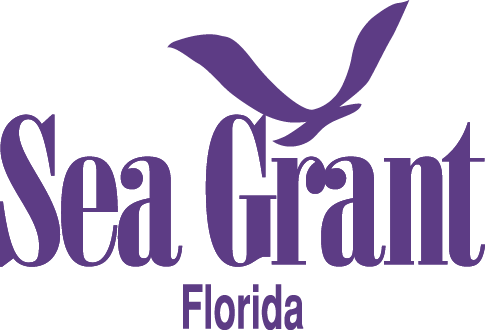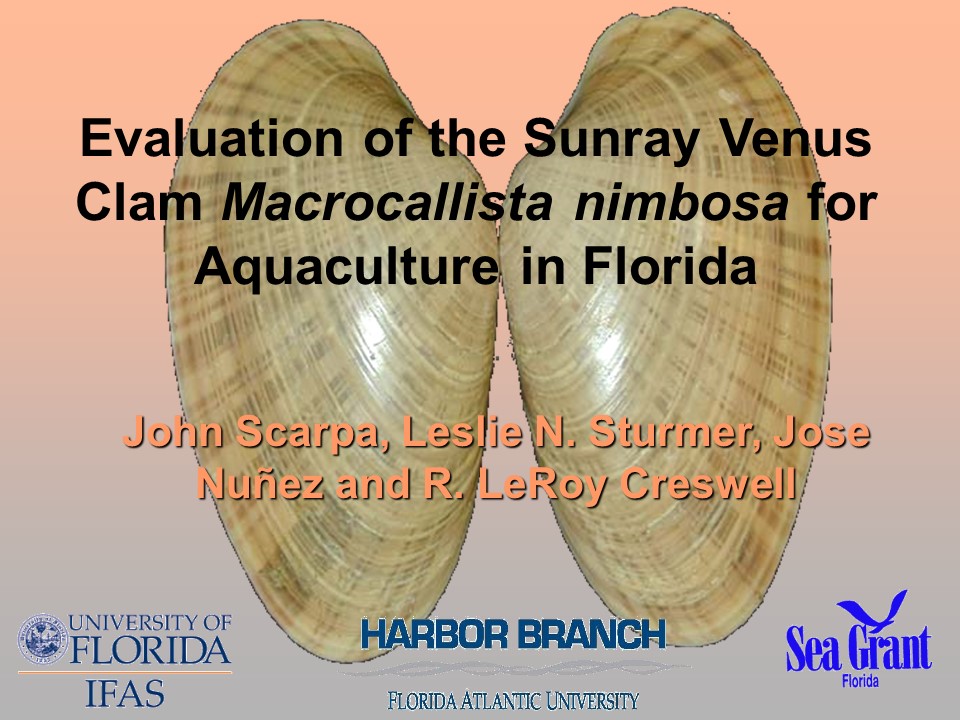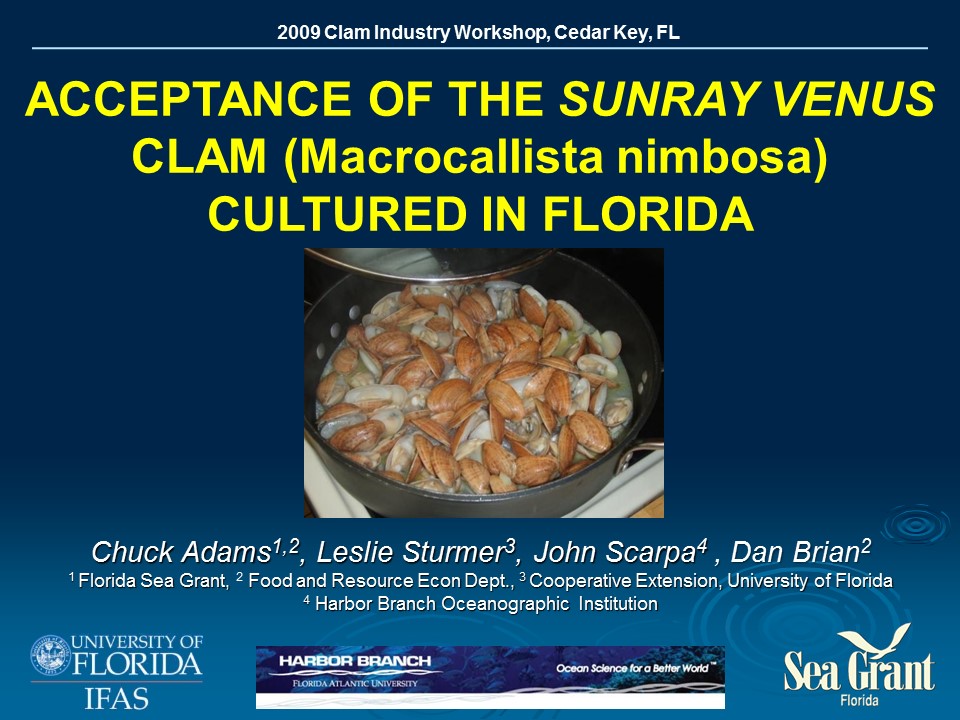Home » Sunray Venus Clams » Florida Sea Grant Projects » Florida Sea Grant Project, 2006-2008

The goal was to develop, evaluate, and demonstrate biological and technical methods to spawn and culture the sunray venus clam. The work was aimed at introducing a new molluscan species to shellfish producers, which would have the potential of providing a different revenue source to small-scale hard clam culture enterprises, thus improving farm income. The objectives were to utilize current hard clam methods as a starting point to: 1) identify methods for broodstock handling and spawning, 2) establish hatchery protocols for rearing embryos through larval metamorphosis, 3) grow a group of sunray venus clams from post-set to commercial size, 4) characterize financial considerations of hatchery production, and 5) test market perception of cultured sunray venus clams at restaurants.
Seed Production: Adult sunray venus clams were collected from natural assemblages near St. Teresa and Seahorse Key, Florida and shipped to the HBOI-FAU experimental mollusk hatchery in Fort Pierce. Clams were then placed either in aragonite substrate or no substrate in temperature-controlled tanks (20-25°C, 30-32 ppt), fed microalgae daily, and observed for mortality. Broodstock clams did not exhibit excessive mortality from overnight shipping (i.e., <11% after one week). Histological analysis of gonad tissue indicated an approximate 1:1 female to male ratio. Induced spawning was attempted using thermal-cycling (10°C increase) and sperm-addition, which resulted in the first ever successful induced spawning of both male and female sunray venus clams in November 2006. Approximately one month later a second induced spawn was accomplished using thermal-cycling and serotonin injection. Thermal induction yielded viable gametes that resulted in D-stage larvae the following day, whereas only sperm from serotonin-injected animals was able to fertilize eggs from thermally induced animals with resulting D-stage larvae. Eggs from serotonin-injected animals did not develop when fertilized with sperm from a thermally induced animal. Larvae were fed microalgae (Isochrysis sp., clone T-ISO) daily and water (30-31 ppt, 26-28°C) was changed daily. Larval development was similar to hard clams; pediveligers (~220 µm) were noted at day seven at which time they were placed in downwellers without or with substrate (sand, aragonite). Metamorphosis occurred over several days in all treatments. Settled clams were fed mixtures of T-ISO and a diatom and water was changed every other day. Three months after settlement, clams from both spawns were enumerated by volumetric sampling; groups in substrate had higher returns than without substrate. The first spawn exhibited a 63% total return and the second spawn exhibited a 46% total return. A feed density trial was initiated with juveniles to determine maximum cell density for growth. Triplicate 4-L beakers each containing 24 clams (42±3 mg) were fed 0, 50, 100, or 200 K cells/mL of Isochrysis sp. twice/day over a four-week period. Growth (% change) did not increase above the 100K cells/mL treatment. Filtration rates, in general, decreased with increasing cell density. Sunray venus clam seed were distributed to industry partners for further nursery culture in upwellers, downwellers, or sand-filled trays.
Growout Production: Production performance of sunray venus clams under field nursery and growout conditions was preliminarily evaluated during 2007-8. Sunray venus seed (about 118,000; 9-18 mm shell length, SL) were field-planted in nursery systems (soft bags and hard cages) at densities of 100-550/ft². After 42-128 days, survival ranged from 32-94% and monthly growth rate was 3.4-6.5 mm SL. Sunray venus juveniles (average: 27 mm SL; 10 mm shell width, SW) were further cultured in hard cages and soft bags at densities of 42-55/ft². After 11 months, sunray venus (61-67 mm SL, 22-23 mm SW, 30-37 grams total weight, 8.1-9.1 condition index) were harvested for market acceptance studies. Survivals ranged from 50-82%. Hard clam methods for field nursery and growout of sunray venus clams yielded acceptable results. Initial trial production efforts appeared successful; however, shell deformities were noted, which seemed to be gear and/or substrate-related, and must be resolved. This effort represented the first documentation of hatchery-produced sunray venus grown under culture conditions in open-water environments. Although the number of sunray venus clams produced was low, one group each from commercial aquaculture lease areas in two counties (Franklin and Levy) were cultured through potential market size. At the Cedar Key site, “market-size” sunray venus (average: 63 mm SL, 22 mm SW) were produced from post-set seed (>2.0 mm sieved seed, ~5 mm SL) in 16 months; whereas, hard clams require about 18 to 24 months to reach “littleneck” size (~50 mm SL, 25 mm SW). These results provided guidelines for future efforts of researchers and shellfish growers.
Consumer Acceptance: The market acceptance of the cultured sunray venus clam was demonstrated within the north Florida market area. A group of four restaurants agreed to participate in a consumer acceptance study. Each restaurant received a given number of cultured sunray venus clams (53-65 mm or 2.1-2.6” SL, 23-37 g or 12-20/lb weight) each week for a period of four weeks (October 2008). Most sunray venus clams were served steamed, baked, or broiled. The wait staff were instructed to ask each patron who consumed the clams to complete a brief tableside survey. The survey solicited the patron’s reaction to various attributes of the sunray venus clams they just consumed. Within participating restaurants, 239 patrons tried sunray venus clams and completed surveys. Most respondents were only slightly hesitant to try cooked sunray venus clams. Only 11% of the respondents detected any grittiness in the clams. For all respondents, 94% were willing to order the product again, and 97% were willing to recommend the product. The survey findings provided insight into the acceptance of cultured sunray venus clams as a viable seafood product and the willingness of consumers to purchase the product.
For more information about this project, view the final report and market acceptance report below, as well as presentations made at state, regional, and national meetings.
A New Species to Diversify the Florida Clam Aquaculture Industry: Final Report, 23 pages (pdf file)
Market Assessment of Cultured Sunray Venus Clams, 16 pages (pdf file)
Evaluation of the Sunray Venus Clam for Florida Aquaculture: Seed Production
Presented at the Florida Clam Industry Workshop, Cedar Key, FL and Aquaculture America, Orlando, FL
Consumer Acceptance of Cultured Sunray Venus Clams by Resaurant Patrons
Presented at the Florida Clam Industry Workshop, Cedar Key, FL and National Shellfisheries
Association Annual Meeting, Savannah, GA
Presented at the Florida Clam Industry Workshop, Cedar Key, FL
John Scarpa, Harbor Branch Oceanographic Institute at Florida Atlantic University
Leslie Sturmer, University of Florida IFAS, Shellfish Aquaculture Extension
Chuck Adams, University of Florida IFAS, Food Resource and Economics Department
Jose Nuñez, University of Florida, The Whitney Lab
LeRoy Creswell, University of Florida IFAS, Florida Sea Grant Extension

